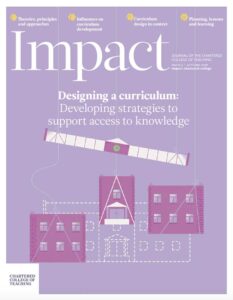Applying the ‘powerful knowledge’ principle to curriculum development in disadvantaged contexts

Michael Young and colleagues’ principle of ‘powerful knowledge’ (Young et al., 2014) reignited debate about how the school curriculum can be a tool for social justice. Based on my experience as a primary school teacher in a disadvantaged area, I reflect on what powerful knowledge is, why it is an important curriculum principle and how it might be applied.
What is ‘powerful knowledge’?
Young (2014, p. 74) explains that knowledge is powerful ‘if it predicts, if it explains, if it enables you to envisage alternatives’. Building on this, he provides three distinctions or criteria for ‘powerful knowledge’:
1. It is distinct from the ‘common sense’ knowledge we acquire through everyday life
We will grasp knowledge about where we live and other aspects of life through our daily experience. This is important, but it is limited to the context in which we live. Schools should seek to surpass this, giving us knowledge that we wouldn’t otherwise have access to.
2. It is systematic
The concepts of powerful knowledge are ‘systematically related to each other’ in groups that we call subjects or disciplines’ (p. 75). Powerful knowledge therefore allows us to generalise and think beyond particular contexts.
3. It is specialised
Powerful knowledge has been developed ‘by clearly distinguishable groups, usually occupations, with a clearly defined focus or field of enquiry’ (p. 75). These groups include a range of experts, from scientists and mathematicians, to novelists and musicians.
Why should ‘powerful knowledge’ be a curriculum principle for schools in disadvantaged contexts?
Powerful knowledge can ‘enable students to acquire knowledge that takes them beyond their own experiences’ (Young et al., 2014, p. 7). This is particularly important in disadvantaged contexts in relation to the promotion of social justice. In Young et al.’s (2014) view, it is the educational right of the child to receive a comprehensive education committed to academic excellence – regardless of background or social standing. Knowledge-led curricula attempt to provide young people with a school experience that enables them to be socially mobile, for this is at the core of what social justice is: enabling all people, regardless of socio-economic background, to be provided with the opportunities to succeed in life.
‘Powerful knowledge’ should not be simply equated with the curricula of traditional public schools. The sorts of knowledge that Young et al. (2014) advocate might include aspects of ‘the canon’ – but they may also include knowledge that meets the criteria above, taking students beyond their everyday experiences.
How might it be applied in practice?
The National Curriculum provides the knowledge that is ‘essential’ for students to learn. However, it must be interpreted and appliedacross a wide variety of school contexts in England. Even if textbooks and detailed planning are used to aid this transition, there is still a plethora of pedagogic strategies – particularly the sequencing and teaching of knowledge – that will vary between classrooms. As such, I argue that all teachers, not only school leaders, are ‘curriculum makers’ (Lambert, 2014).
Therefore, the question of ‘what should I teach?’, once the National Curriculum, syllabus and exam specification has been established, is related to ‘powerful knowledge’. Teachers must consider the balance between breadth and depth, idea sequencing, factual and conceptual knowledge and choice of texts; all this comes beforeplanning lessons and gathering resources. Curriculum making, then, is guided by aims and purposes before objectives and success criteria.
Curriculum making
Adapting the work of the ‘Manifesto’ of the Geographical Association (GA, 2009), Lambert’s (2014) work and my own recent dissertation work (Burns, 2018), I propose a model for curriculum making in primary schools (Figure 1).
The model in Figure 1 represents the intersection of the National Curriculum with the work of teachers in classrooms. Of course, the model doesn’t fully represent the complexity of the three areas of curricula making; however, it does present the need for curriculum to be balanced between influences. Too much focus on student experiences and context will neglect the teacher expertise and curriculum knowledge. Similarly, too much focus on the curriculum knowledge might mean that students struggle to reconcile their own experiences and context with the knowledge being taught. The curriculum knowledge that will take students beyond their own experience must be carefully orchestrated to relate to the context in which they live.
Below are three ways that schools could build on the model and apply it in the classroom.
1. Enable subject leadership to incorporate subject knowledge development
This first practical suggestion is that subject leaders focus their CPD on knowledge development amongst non-specialist staff members. This will enable two things: firstly, it will build confidence in staff members to teach subjects that they may not have had much experience with previously. Secondly, it will guide the pedagogical strategies that teachers choose. For example, teachers having a detailed knowledge of the features of rivers would mean that they might feel more empowered on a school trip to identify them accurately and explain them confidently to pupils within a real context, rather than through worksheets and videos.
2. Approach planning with a ‘powerful knowledge’ focus
By curating ‘knowledge organisers’ (KOs), which systematically outline the knowledge that is to be taught for each subject or topic, teachers can ‘read around’ the subject to ensure they know everything that is needed before teaching. They can also use it to refer back to what should be learned by the end of the topic (see pages 70 – 72 for more on the purpose and pedagogy of knowledge organisers).
3. Sequence learning cumulatively across year groups
Use KOs to ensure that the knowledge taught in each year group doesn’t get repeated and that, from the moment students come to school to the moment they leave, they are receiving well-sequenced, powerful knowledge that will take them beyond their everyday experiences.
This brief overview of ‘powerful knowledge’ has explored how it might be applied within school curriculum making, giving students the knowledge they need to go beyond their own experiences towards greater social mobility.











